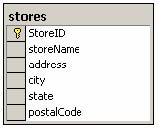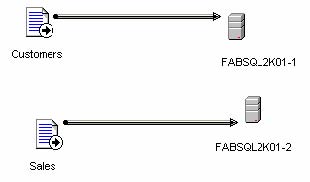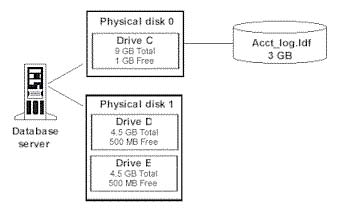You are the administrator of a SQL Server 2000 computer. You are creating a data transformation services package. As the first step in this process, you need to load data from text files into a database table. These text files contain data on new stores that join your franchise. The text files list the data columns in the following format StoreID, StoreName, Address, City, State, PostalCode, ManagerID, StoreTypeID, FacilityID.
The destination table is configured as shown in the exhibit.

You want to load the data into the table as quickly as possible. What should you do?
A.Use a Bulk Insert Task to read the data into a temporary table. Use an Execute SQL task to import the appropriate data into the destination table.
B.Create and edit a format file to select the columns you want to import. Use a Bulk Insert Task, and then specify the format file to import the appropriate data into the destination table.
C.Use a transform. data task to import the data. Use Microsoft ActiveX transformation scripts to write the appropriate data to the appropriate columns in the destination table.
D.Create and edit a format file to select the columns you want to import. Use a transform. data task, and then specify the format file to import the appropriate data into the destination table.
第1题:
You are the administrator of a SQL server computer. The server is running SQL Server 6.5 and SQL Server 7.0.
You install a named instance of SQL Server 2000, and then run the SQL server upgrade wizard. On the database selection screen, some of the SQL Server 6.5 databases are not listed.
You cancel the SQL Server upgrade wizard.
You need to ensure that the SQL Server 6.5 databases are listed in the wizard. What should you do?
A.Uninstall SQL Server 7.0, and then rerun the SQL Server upgrade wizard.
B.Run the Microsoft SQL Server-switch application, and then rerun the SQL Server upgrade wizard.
C.Create a data transformation services package that imports the databases from SQL Server 6.5 to SQL Server 2000, and then execute the package.
D.Uninstall SQL Server 2000, and then reinstall SQL Server 2000 as the default instance.
第2题:
You are the administrator of a SQL Server 2000 computer in your company's personnel department. Employee data is stored in a SQL Server 2000 database. A portion of the database schema is shown in the exhibit.

You want to create a text file that lists these data columns in the following format title, FirstName, LastName, WorkPhone, PositionName, DepartmentName.
You want to create the text file as quickly as possible. You do not expect to re-create this file, and you want to avoid creating new database objects if possible.
What should you do?
A.Use the bcp utility to export data from each table to a separate text file. Use format files to select the appropriate columns. Merge the data from each text file into a single text file.
B.Create a view that joins data from all three tables include only the columns you want to appear in the text file. Use the bcp utility to export data from the view.
C.Create a SELECT query that joins the data from the appropriate columns in the three tables. Add an INTO clause to the query to create a local temporary table. Use the bcp utility to export data from the local temporary table to a text file.
D.Create a SELECT query that joins the data from the appropriate columns in the three tables. Add an INTO clause to the query to create a global temporary table. Use the bcp utility to export data from the global temporary table to a text file.
第3题:
You are the database administrator for a retail company. The company owns 270 stores. Every month, each store submits approximately 2,000 sales records, which are loaded into a SQL Server 2000 database at the corporate headquarters.
A Data Transformation Services (DTS) package transforms the sales records, as they are loaded. The package writes the transformed sales records to the Sales table, which has a column for integer primary key values. The IDENTITY property automatically assigns a key value to each transformed sales record.
After loading this month's sales data, you discover that a portion of the data contains errors. You stop loading data, identify the problem records, and delete those records from the database.
You want to reuse the key values that were assigned to the records that you deleted. You want to assign the deleted key values to the next sales records you load. You also want to disrupt users' work as little as possible.
What should you do?
A.Export all records from the Sales table to a temporary table. Truncate the Sales table, and then reload the records from the temporary table.
B.Export all records from the Sales table to a text file. Drop the Sales table, and then reload the records from the text file.
C.Use the DBCC CHECKIDENT statement to reseed the Sales table's IDENTITY property.
D.Set the Sales table's IDENTITY_INSERT property to ON. Add new sales records that have the desired key values.
第4题:
You are the administrator of a SQL Server 2000 computer. The server contains a database that stores financial data. You want to use Data Transformation Services packages to import numeric data from other SQL server computers. The precision and scale values of this data are not defined consistently on the other servers.
You want to prevent any loss of data during the import operations. What should you do?
A.Use the ALTER COLUMN clause of the ALTER TABLE statement to change data types in the source tables. Change the data types so that they will use the lowest precision and scale values of the data that will be transferred.
B.Use the ALTER COLUMN clause of the ALTER TABLE statement to change data types in the destination tables. Change the data types to reflect the highest precision and scale values involved in data transfer.
C.Set a flag on each DTS transformation to require an exact match between source and destination columns.
D.Set the maximum error count for each DTS transformation task equal to the number of rows of data you are importing. Use an exception file to store any rows of data that generate errors.
E.Write Microsoft ActiveX script. for each DTS transformation. Use the script. to recast data types to the destinations precision and scale values.
第5题:
You are the administrator of a SQL Server 2000 computer. Your company uses the server to store service contract information for its customers.
You are also the administrator of Oracle relational database management system (RDBMS) server.
This server is used to store your company’s financial information. The financial information is updated frequently throughout the day.
You need to create a series of reports that combine the service contract information and the financial information. These reports will be updated several times a day.
You want to create reports on the SQL Server computer by using the minimum amount of disk space.
What should you do?
A.Set up SQL server replication to replicate the data from the oracle server to the SQL server computer.
B.Set up the oracle server as a linked server. Create a view that joins the service contract information and the financial information.
C.Set up data transformation services (DTS) package that imports and transforms the database from the oracle server to the SQL server computer. Use SQL server agent to execute the DTS package throughout the day as needed.
D.Set up Microsoft ActiveX script. that connects to the oracle server and imports the financial information into SQL server temporary table. Create a view that joins the service contract information and the temporary table.
第6题:
You are the administrator of SQL Server 2000 computer named FABSQL2K01. You create a Data Transformation Services package that contains definition for two transform. data tasks.
The tasks gets data from two text files named Customers and Sales. The DTS package is configured as shown in the exhibit.
You do not want the DTS package to add any data to the server unless both transform. data tasks complete successfully.
You select the use transactions check box of DTS package and the Join transaction of present check box of both transform. data tasks. You then select the fail package on step failure check box of both transform. data tasks.
You want to use the DTS package to import data from the text files to the server. You want to ensure that changes are committed if all imported data is successfully transformed.

What should you do?
A.Select the commit on successful completion check box of the DTS package.
B.Select the commit transaction on successful completion of this step check box of the customers transform. data task.
C.Select the commit transaction on successful completion of this step check box of the sales transform. data task.
D.Select the commit transaction on successful completion of this step check box of both transform. data tasks.
第7题:
You are the administrator of a SQL Server 2000 computer. You create a Data Transformation Services (DTS) package. The package is stored as a local package on the server. The package exports data from an online transaction processing (OLTP) database system to an online analytical processing (OLAP) database system that is located on a second SQL Server 2000 computer.
You want the package to execute automatically each evening at 8:00 P.M. What should you do?
A.Use SQL Server Enterprise Manager to create a new job Create a CmdExec job step that runs the dtsrun utility Schedule the job to run each night at 8:00 P.M.
B.Use SQL Server Enterprise Manager to create a new job Create a Transact-SQL job step to query data from the OLTP database Create a second Transact-SQL job step to launch the DTS package Schedule the job to run each night at 8:00 P.M.
C.Create a batch file that runs the dtsrun utility Use the Microsoft Windows Task Scheduler to run the job each night at 8:00 P.M. Configure the Windows Task Scheduler to use the local system account
D.Move the DTS package to the repository Configure the SQLServerAgent service on the OLAP database server to update the package each night at 8:00 P.M.
第8题:
You are a database administrator in the Los Angeles branch office of a specialty foods supplier. A mainframe. database at the headquarters contains all company data. Each branch office contains a SQL Server 2000 computer that imports regional data from the mainframe. database.
The server in Los Angeles contains a Data Transformation Services (DTS) package that uses OLE DB to connect to the company's mainframe. database. The DTS package extracts and transforms data about buyers and products for that region. The DTS package then writes the data to the SQL Server database in Los Angeles.
You need to configure a SQL Server computer for the new branch office in Sydney. You want to copy the Los Angeles package and modify it so that it writes data to the SQL Server database in Sydney.
You use the DTS Designer to modify the DTS package so that it imports regional data from the mainframe. database to the server in Sydney. The modified DTS package runs successfully on the server in Los Angeles. You save this DTS package to the server in Sydney, but the server in Sydney cannot connect to the mainframe. database.
You want to enable the server in Sydney to connect to the mainframe. database. What should you do?
A.Change the connection properties in the DTS package so that the package uses new login credentials to connect to the mainframe. database.
B.Modify the workflow in the DTS package so that the server in Sydney is included.
C.On the server in Sydney, install an OLE DB provider for the mainframe. database.
D.On the server in Sydney, delete and then re-create the DTS package.
第9题:
You are the administrator of a SQL Server 2000 computer. The server contains a database named Acct. You purge the Acct database of old records and perform. a full backup. The database now uses 4 GB of space. The database files are configured as shown in the Acct Properties exhibit.

The server has two hard disks that are configured as shown in the Server Configuration exhibit.

The 3 GB transaction log file for the Acct database is stored on drive C. You need to make room for a new database that has a 3 GB data file and a 1 GB transaction log file. You want to optimize database performance on both databases. You also want to minimize administrative overhead.
What should you do?
A.Shrink the empty data file on drive E. Place the new data file and the new log file on drive E.
B.Shrink the empty data file on drive E. Backup and shrink the log file on drive C to 2 GB. Place the new data file on drive E and the new log file on drive C.
C.Shrink the data file on drive D to 1 GB, and then shrink the data file on drive E to 2 GB. Place the new data file on drive D and the new log file on drive E.
D.Shrink and delete the data file on drive C, and then shrink the database files on drives D and E so that they are both 2 GB. Place the new data file and the new log file on drive C.
第10题:
You are the administrator of a SQL Server 2000 computer. Your company purchased an accounting application from a vendor. The application stores its data in a database named Accounting on the server. The tables in this database contain columns that function as primary keys, but PRIMARY KEY and FOREIGN KEY constraints are not used.
You need to replicate data from this database to another SQL Server computer. This server will use the replicated data to generate reports. Most reports will run each month, but the accounting department needs to have the ability to run reports at any time. Reports should be accurate through the last full working day.
You cannot make any changes to the database, but you need to implement replication. Which two actions should you take? (Each correct answer presents part of the solution. Choose two)
A.Implement merge replication.
B.Implement snapshot replication.
C.Implement transactional replication.
D.Schedule replication to run continuously.
E.Schedule replication to run during off-peak hours.